When you choose your salad greens, feel free to mix varieties for more interest. We like to combine light and dark greens, as well as mild and spicy ones. Examples include arugula and romaine, Bibb lettuce and mustard greens, spinach and endive, or all of them. The more the merrier!
You can buy triple-washed greens, but keep in mind that they tend to go bad more quickly and lose some of their flavor and freshness. There’s also disagreement over washing pre-washed vegetables or not. We look at the “sell-by” date and choose one with at least a week before that date . If the date is in the next few days, we don’t buy it. At home, we open the package and sniff. If it smells good and appears to be dry and fresh, we usually don’t wash it. If it has an unpleasant odor, we’ll rinse it well and remove any damaged leaves. When in doubt, play it safe and wash it first, but make sure everything is very clean to avoid cross-contamination. (This is another reason we like to use a salad spinner that is dedicated to raw vegetables.)
Some greens like spinach, romaine hearts and endive are easier to chop or slice first, then wash in the salad spinner. You’ll rinse out the grit that is sometimes found inside, and you won’t end up with a big puddle of water on your cutting board and counter.
In addition to the “sell-by” date, packaged greens will usually indicate if they’ve been pre-washed or not. If there is no indication, err on the side of caution and assume that they have not been washed yet.
If you wash your greens, you’ll need to spin or pat them dry before continuing. If you don’t have a salad spinner and plan to make salads frequently, we recommend you get one. Otherwise, wash greens well in a colander and pat dry on clean dish towels or paper towels. Leaving water on the greens will cause them to go bad more quickly and will prevent the dressing from sticking and coating the leaves.
Once your greens are done, it is just a matter of adding toppings! We suggest you try different variations to see what you like. Our rules of thumb are:
- Add color! You can do this with some bell pepper, red cabbage, carrots or whatever vegetables you like.
- Add a protein. Some of our favorites are beans but you can also throw in some leftover chicken, salmon, nuts, cheese or hard boiled eggs.
By following these directions for building a salad, you’ll find it much easier to throw a salad together to take to work or eat at home every day. You might also be surprised how filling a packed salad can be.
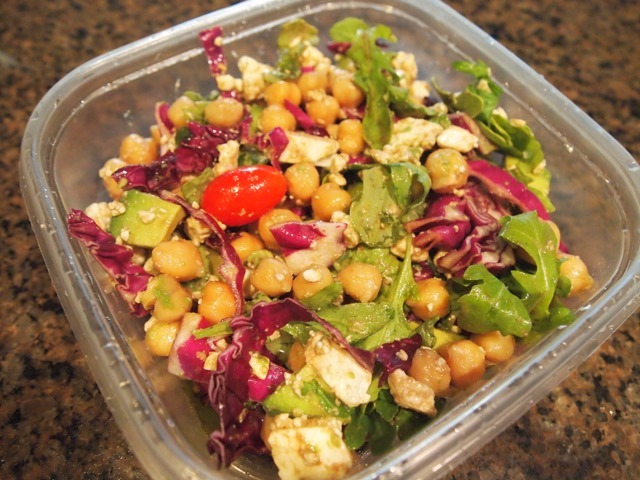
Making your own dressings is almost too easy not to do! Some of our favorites are Basic Vinaigrette and French Vinaigrette. What are your favorite dressings?
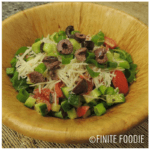
| Prep Time | |
| varies |
|
|

Easy!
Varies
Serves:8people
Serving Size:1 cup (minimum)
|
Of course, you don't need a "recipe" for making a salad, but these tips might make it easier.
Tools:salad spinner (optional), knife and cutting board, grater (optional), large airtight bowl with lid (or use a glass bowl and plastic wrap), paper towels
|
- 6 cups fresh arugula or other greens
- 1/2 cup red cabbage thinly sliced or chopped
- 1/2 cup celery sliced
- 1/2 cup carrots grated
- 1/2 cup radishes thinly sliced or grated
- cucumbers
- bell peppers
- zucchini and/or yellow squash
- broccoli
- cauliflower
- cherry tomatoes or diced tomatoes
- sugar snap peas
- sprouts
- herbs
- avocado
- marinated artichoke hearts
- olives
- Choose salad greens; rinse and spin or pat dry if needed.
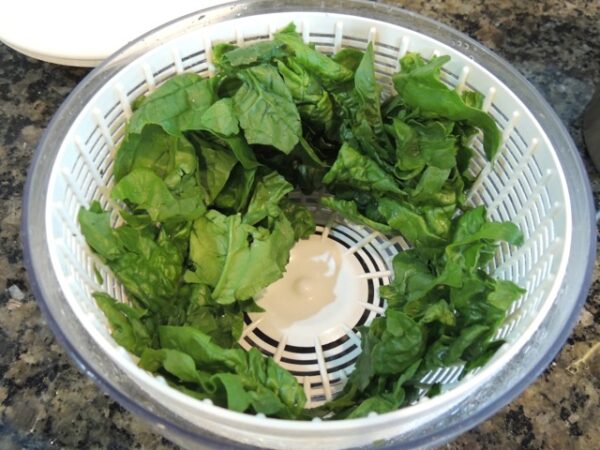
- Place a paper towel in the bottom of a large bowl. We use a large Tupperware container with a lid. You will remove this towel later, but for now, it will soak up excess moisture that falls to the bottom. Place the greens in the bowl, on top of the paper towel.
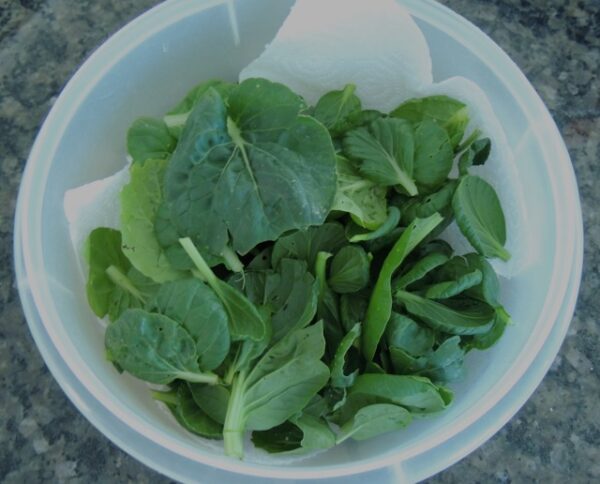
- Chop some red (or green) cabbage and celery. Sprinkle on top of the greens.
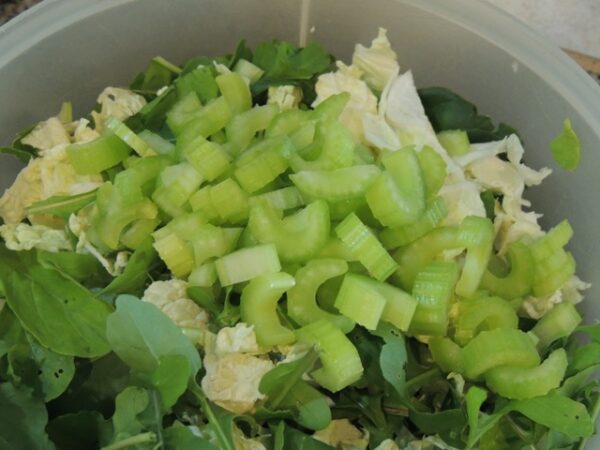
- Grate or slice a carrot and radishes or other root vegetables like turnips, beets, jicama, kohlrabi, etc. If you add red beets, they tend to stain anything they touch, so we prefer to use golden beets or keep them separate to add right before serving.
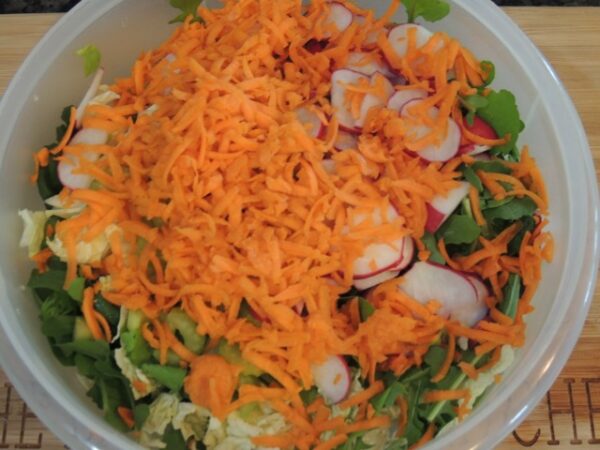
- Grab the corner of the paper towel that’s lining the bowl and pull it out. Using a salad serving set or a large spoon and fork, toss the salad until well mixed.

- Place a clean paper towel gently over the salad and seal with an airtight lid or plastic wrap. Store in the refrigerator.
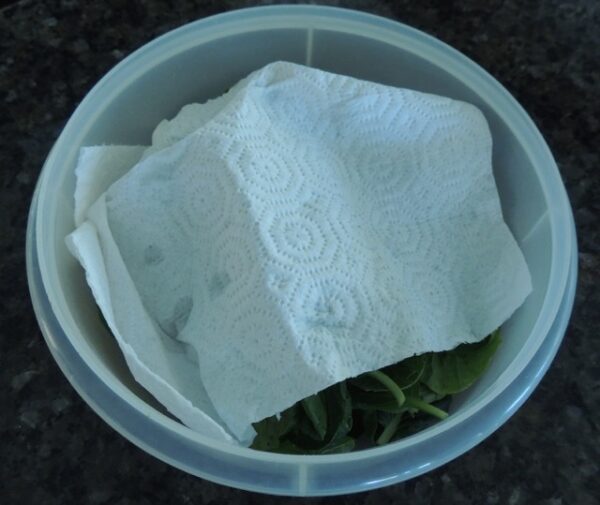
- Some of the add-ins can be prepared ahead of time and stored in airtight containers. These don’t keep as long as the base salad ingredients, so they are best stored separately and in smaller amounts that will be used up in a few days. We also wash some cherry tomatoes and sometimes cut them in half before storing them. Always cut and add avocado right before serving.
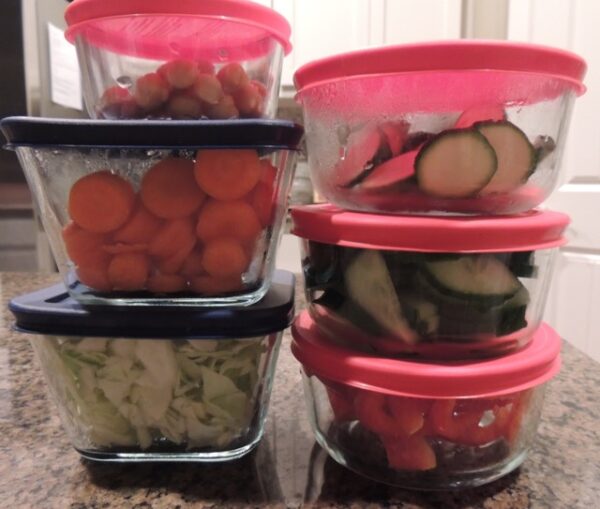
- When ready to eat, remove the desired amount of the base salad and toss in some of your add-ins.

- We usually use oil, vinegar, salt and pepper, but sometimes we'll make homemade vinaigrette or one of our other salad dressings. Once you learn how easy and tasty it is to make your own, you’ll never want to buy grocery-store salad dressings again!
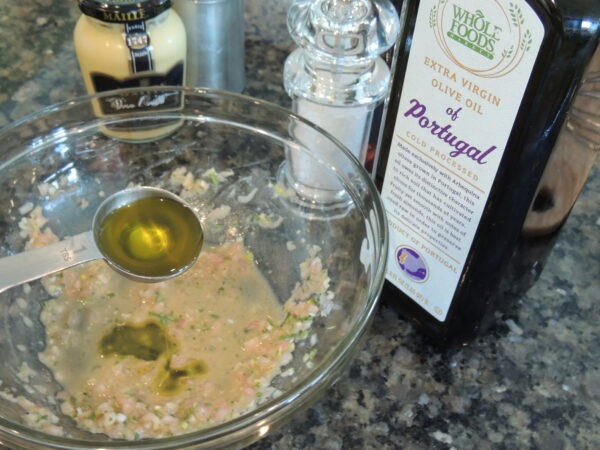
VARIATIONS: (limitless)
- Add fruit like strawberries, apples, pears, figs, mango, papaya, orange or grapefruit segments, blueberries, raisins, dried cranberries, etc. If you do, you’ll want to keep the other ingredients simple. A little onion goes well with fruit, as do most plain vegetables, but don’t add too many.
- Add a protein like cheese, nuts, beans, tuna, salmon, chicken, hard-boiled egg, etc.
- Add cooked quinoa, rice or pasta.
- Add leftover cooked vegetables like green beans, asparagus, broccoli, etc.
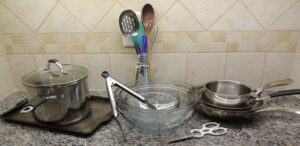
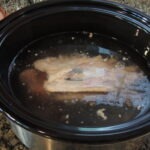
Leave a Reply
You must be logged in to post a comment.